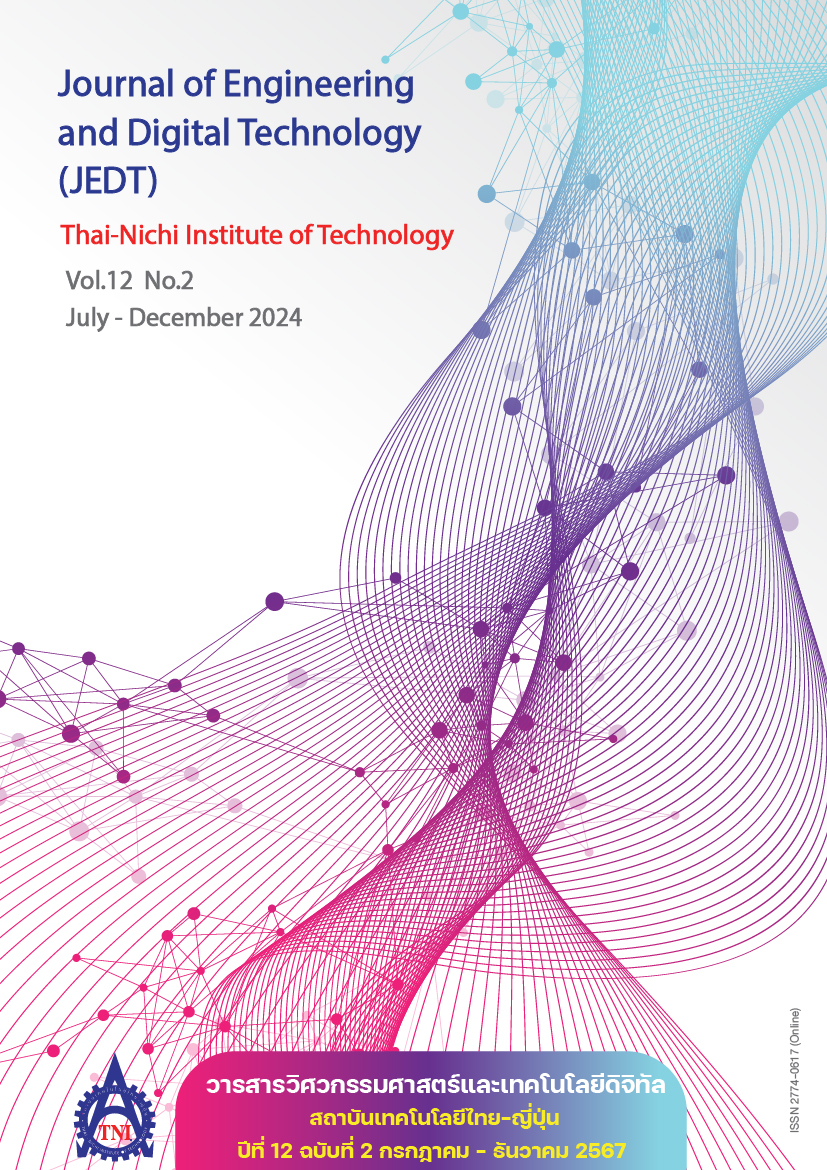A Model to Predict the Failure of Centralized Air Conditioners with Variable Refrigerant Flow Using Machine Learning
Main Article Content
Abstract
The objective of this research was to develop a predictive model for failure events of variable refrigerant flow air conditioning systems using machine learning techniques. The air conditioning failure events were attributed to the amount of refrigerant. The researcher utilized the RapidMiner Studio software to construct models from four algorithm types: Decision Tree, Naïve Bayes, Support Vector Machine, and Neural Networks. The dataset used consisted of 402 records of variable refrigerant flow air conditioning systems Better Cool Co., Ltd., containing features such as refrigerant pressure, subcooled value, superheated value, number of units turned on/off, and operational status (normal or faulty). To evaluate model performance, the accuracy, precision, recall, and F-measure metrics were calculated and compared across the algorithms. The Neural Networks algorithm demonstrated the highest performance, achieving 95.04% accuracy, 94.17% precision, 100% recall, and 97.00% F-measure, enabling accurate prediction of normal or faulty operational status.
Moreover, the researcher enhanced the model using the Stacking Hybrid Ensemble Method technique. This involved combining the top three performing algorithms: Neural Networks, Decision Tree, and Naïve Bayes, for classification. Consequently, the performance metrics improved, with an accuracy of 95.52%, precision of 97.21%, recall of 97.21%, and an F-measure of 97.21%.
Article Details

This work is licensed under a Creative Commons Attribution-NonCommercial-NoDerivatives 4.0 International License.
Article Accepting Policy
The editorial board of Thai-Nichi Institute of Technology is pleased to receive articles from lecturers and experts in the fields of engineering and technology written in Thai or English. The academic work submitted for publication must not be published in any other publication before and must not be under consideration of other journal submissions. Therefore, those interested in participating in the dissemination of work and knowledge can submit their article to the editorial board for further submission to the screening committee to consider publishing in the journal. The articles that can be published include solely research articles. Interested persons can prepare their articles by reviewing recommendations for article authors.
Copyright infringement is solely the responsibility of the author(s) of the article. Articles that have been published must be screened and reviewed for quality from qualified experts approved by the editorial board.
The text that appears within each article published in this research journal is a personal opinion of each author, nothing related to Thai-Nichi Institute of Technology, and other faculty members in the institution in any way. Responsibilities and accuracy for the content of each article are owned by each author. If there is any mistake, each author will be responsible for his/her own article(s).
The editorial board reserves the right not to bring any content, views or comments of articles in the Journal of Thai-Nichi Institute of Technology to publish before receiving permission from the authorized author(s) in writing. The published work is the copyright of the Journal of Thai-Nichi Institute of Technology.
References
Department of Public Works and Town & Country Planning. “Roles and Responsibilities.” DPT.go.th. https://www.dpt.go.th/th/powers-and-duties-of-departments-and-government-agencies (accessed Oct. 19, 2023).
Green Government Office Design Guidelines for New Construction. G-Goods : NC Version 1.0 (in Thai), Department of Public Works and Town & Country Planning, Dec. 2022. [Online]. Available: https://www.dpt.go.th/th /documents-dpt/961
R. E. Neapolitan and X. Jiang, Artificial Intelligence: With an Introduction to Machine Learning, 2nd ed. New York, NY, USA: Chapman and Hall/CRC Press, 2018.
T. Jo, “Introduction,” in Machine Learning Foundations: Supervised, Unsupervised, and Advanced Learning. Cham, Switzerland: Springer International Publishing, 2021, ch. 1, pp. 1–15.
B. Charbuty and A. M. Abdulazeez, “Classification based on decision tree algorithm for machine learning,” J. Appl. Sci. Technol. Trends, vol. 2, no. 1, pp. 20–28, Jan. 2021.
N. S. Chauhan. “Decision Tree Algorithm, Explained.” KDNUGGETS.com. https://www.kdnuggets.com/2020/01/decision-tree-algorithm-explained.html (accessed Feb. 19, 2024).
T. N. Viet, H. L. Minh, L. C. Hieu, and T. H. Anh, “The Naïve Bayes algorithm for learning data analytics,” Indian J. Comput. Sci. Eng., vol. 12, no. 4, pp. 1038–1043, 2021.
R. Akbani, S. Kwek, and N. Japkowicz, “Applying support vector machines to imbalanced datasets,” in Proc. 15th Eur. Conf. Mach. Learn., Pisa, Italy, Sep. 2004, pp. 39–50.
A. C. Müller and S. Guido, “Supervised Learning,” in Introduction to Machine Learning with Python: A Guide for Data Scientists. Sebastopol, CA, USA: O'Reilly Media, 2016, ch. 2, pp. 106–120.
S. Bandgar. “Support Vector Machine.” MEDIUM.com. https://medium.com/nerd-for-tech/support-vector-machine92fa3c57d33b (accessed Feb. 19, 2024).
S. Krishna. “Building an Artificial Neural Network(ANN).” MEDIUM.com. https://medium.com/@saikrishna3599/building-an-artificial-neural-network-ann-502a63d76fb3 (accessed Jun. 30, 2020).
S. Pal and S. Paul, “Linking hydrological security and landscape insecurity in the moribund deltaic wetland of India using tree-based hybrid ensemble method in python,” Ecological Inform., vol. 65, Sep. 2021, Art. no. 101422.
J. Zhao, J. Jin, S. Chen, R. Zhang, B. Yu, and Q. Liu, “A weighted hybrid ensemble method for classifying imbalanced data,” Knowl.-Based Syst., vol. 203, Jun. 2020, Art. no. 106087.
T. Srivastava. “12 Important Model Evaluation Metrics for Machine Learning Everyone Should Know (Updated 2023).” ANALYTICSVIDHYA.com. https://www.analyticsvidhya.com/blog/2019/08/11-important-model-evaluation-error-metrics/ (accessed Jan. 8, 2024).
A. Elmouatamid, B. Fricke, J. Sun, and P. W. T. Pong, “Air conditioning systems fault detection and diagnosis-based sensing and data-driven approaches,” Energies, vol. 16, no. 12, Jun. 2023, Art. no. 4721.
M. Yang, L. Cheng, M. Cao, and X. Yan, “A stacking ensemble learning method to classify the patterns of complex road junctions,” ISPRS Int. J. Geo-Inf., vol. 11, no. 10, Oct. 2022, Art. no. 523, doi: 10.3390/ijgi11100523.


